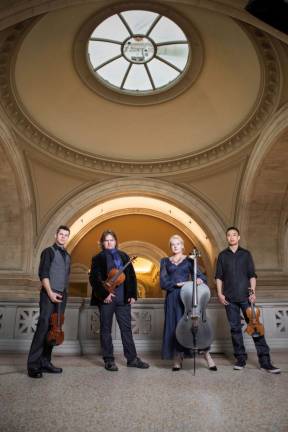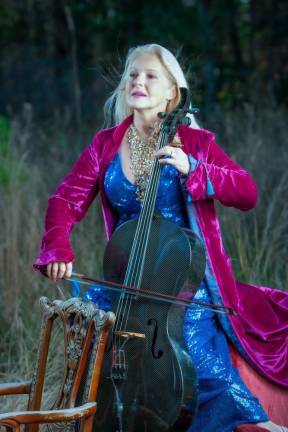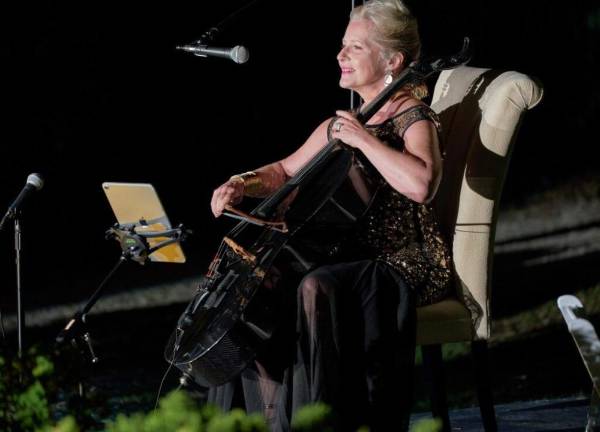Dorothy Lawson and the Ethel String Quartet Are Ready to Release a New Album
The band Ethel, which was co-founded by Dorothy Lawson in 1998, plays regularly at the Metropolitan Museum of Art and will release “Persist,” its latest album, in December.




When Canadian native Dorothy Lawson moved to New York City to study at Juilliard, she was immediately hooked. “New York won my heart. I loved the feeling, the culture, the sense of possibility,” she said.
The longtime Upper West Sider was once considered the go-to cellist in the city, and her impressive resume includes touring with Mikhail Baryshnikov, playing in the orchestra in Broadway’s “The Woman in White” and being a member of the American Symphony for over 20 years.
After 20 years of playing professionally in New York, she co-founded the string quartet Ethel in 1998, which has since played on over 50 albums, and released 12 of its own. The group has changed its members over the years, but Lawson and violinist Ralph Farris have been constants. Their current quartet, which includes violinists Kip Jones and Corin Lee, has been together for a decade.
“This group has been together now for 10 years and honestly, it’s at a prime,” she said. “This is the longest any of the groups have been together actually, and we keep surprising each other. There are always new possibilities, new skills, new tastes that we discover.”
Ethel is also responsible for programming the music at the Metropolitan Museum of Art, so on many weekends, the group can be found performing there. “We get to support other performers as well as ourselves and give people both a chance to be seen, be heard, but also meet the audience. That’s one of the unique things about it,” she said.
On Sept. 24, Ethel will be performing a preview concert of its upcoming album “Persist” at Merkin Hall in the Kaufman Music Center at Abraham Goodman House, 129 W. 67th Street (btw Broadway and Amsterdam),which will also be broadcast live on WNYC Radio’s “New Sounds Live” concert series hosted by John Schaefer.
When did you take your first cello lesson?
I believe I was 9 years old. I had the opportunity through my public school. I like to emphasize that because public school art and music programs have been consistently reduced over many years now. I came from a family where my mother was a well-trained pianist. They were immediately excited and supportive, but they didn’t insist. My mom gave me some very early lessons when I was probably about 2 on the piano, but I didn’t want to do that and I didn’t want to take lessons from her. So it wasn’t until I chose it myself and I was in school that it actually stuck for me. I could do it with friends. I was in a setting where it was normal. It was actually a bonus, kids who took lessons got an hour out of class every week. [Laughs]
Did you move to New York to attend Juilliard?
Yes, I had already finished my undergrad in Canada at the University of Toronto. And I actually opted not to come to New York right away, but went for three years to Vienna. In fact, I felt my strongest teacher was the teacher there, his name was André Navarra. When I came to New York, in my mind, it was to just polish up a bit, but it, of course, was an essential platform and introduction.
Tell us about touring with Mikhail Baryshnikov.
I had already been professional in New York for 20 years before Ethel started. One of the opportunities was when Baryshnikov, post ballet, started about a 10-year career with modern dance. Some of his closest connections, mostly through the American Ballet Theatre, were also friends of mine, and when the group came together to travel with his ensemble, I was one of the people they called. It was so fun and fabulous and glamorous and the group was magnificent and the dancers were mature and interesting. It was the most satisfying kind of artistic experience. Watching an artist like Baryshnikov day after day after day was an amazing education because you got to observe what made a performance of his special. Because every single performance was spotless, he never dropped a beat. There were a few times when he was in an especially high mood and his whole being would kind of glow as he was dancing.
You also played in the orchestra of “The Woman in White” on Broadway.
“The Woman in White” was again a call, an invitation from people who knew me to join that show’s orchestra. I guess my strongest memory of it was that it was one of Andrew Lloyd Webber’s late shows. It’s a brilliant and beautiful score. The story is by Wilkie Collins and it’s about wealthy, English aristocrats in the 1800s. And it opened the same season as Oprah Winfrey’s production of “The Color Purple.” It was insane. It was so out of water, it was so out of its time. I felt it was ill-fated right from the beginning, but it was a beautiful show.
You co-founded Ethel in 1998. How did it come about and who are its members?
The personnel have evolved over many years; we’ve been going for 26 years now. So there are two of the original members, me and my colleague Ralph Farris. We’re kind of the foundation; we’re the lower instruments of the group. And there are two younger violinists now, Kip Jones from Minneapolis and Corin Lee from San Francisco. They’re brilliant. Every time we’ve evolved and invited new members, the group shifts. And each person is a relationship that you want to get deeply into, like a present that you keep opening.
Ethel also won a Grammy.
Yes, we were part of an album with Kurt Elling, a supreme jazz singer, which he had designed with his then-music director Laurence Hobgood called “Dedicated to You,” which was a reenactment of the only album that John Coltrane and Johnny Hartman did. It was a single studio session. They had this magical session together and never did another. And Elling and Hobgood decided to bring back the material and we were the quartet that they brought in and the album won a Grammy, which was just fantastic.
I read that you were the go-to cellist around New York City.
I was for many, many years a very happy and active freelance cellist and I would do many, many things that people asked for for jazz or chamber music or orchestras. I was a member of the American Symphony for over 20 years, a member of a chamber orchestra that used to play at the Metropolitan Museum called Philharmonia Virtuosi. I actually did one season of some freelancing with the New York Philharmonic. But it has been so long now, I’ve been focusing more and more narrowly on Ethel and the traveling was so demanding, that maintaining any kind of New York regularity was challenging.
Tell us about Ethel’s new album.
This one, called “Persist,” is original music that Ethel commissioned from five composers, including our magnificent collaborator Allison Loggins-Hull on the flute. The repertoire is all flute and string quartet. This was funded by the NEA [National Endowment for the Arts]. The other four composers are not nearly as well established, but they’re extremely skillful and promising. The pieces were generated separately, under the same invitation, and no theme was given. We received each of them on their own merit. In learning them, we started to experience a kind of journey, both fascinating and charming. The composers were not in communication with each other, knew nothing of each other’s process, yet the combined effect is very, very satisfying, and they all stand together with great strength.
How often do you perform at the Met?
The Met has music every single weekend, and we program it. That is our contract with them and we love it. We’ve benefited so deeply from working in that way. It’s more like a cabaret setting where you’re close up with people who are having a little drink or snack and they’re in a good mood, they’re in this gorgeous space. We often talk to them; we often get to actually find out who they are and it really is just magical.
To learn more, visit www.ethelcentral.org